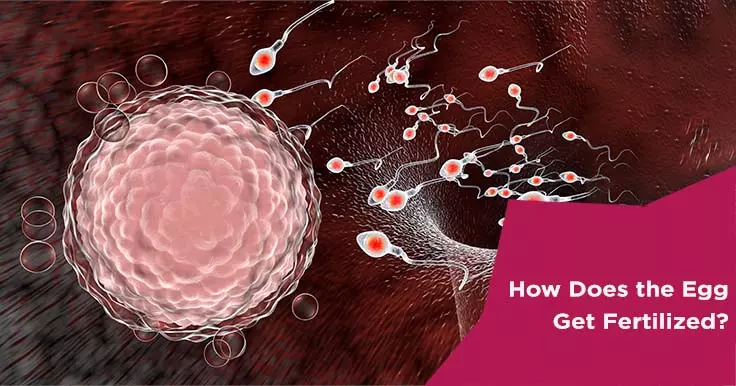All that You Need to Know About Fertilization of Eggs

Fertilisation of eggs is one of the events of conception that is crucial for a healthy pregnancy. The process of fertilisation is closely related to a woman’s menstrual cycle. Women egg formation occurs once every month and one egg is released every month during the menstrual cycle. This is known as ovulation. Ovulation usually occurs 14 days before a period. If this egg is fertilised in time, the woman becomes pregnant. If the egg is not fertilised, it dissolves, and the body sheds the uterine lining during the next period.
Below, we discuss the process and steps involved in the fertilisation of eggs. Keep reading to understand this miraculous and complex procedure of how two cells become one to produce a baby.
What Is Fertilisation?
Fertilisation is the fusion of hereditary material of two different sex cells, one sperm and one egg, each of which carry half the number of chromosomes for a baby. The sex cells are also known as gametes and the fusion of the membranes of these gametes is the first step prominent milestone in fertilisation. This allows the passage of genetic material from one cell to another, which results in the formation of an embryo. As soon as a spermatozoon fuse with the egg, a change in the egg membrane occurs which blocks the attachment of and penetration by another spermatozoon.
In essence, fertilisation of egg is the merging of a sperm and an egg to form an embryo. The fertilisation of eggs is one of the most significant events that is essential for a pregnancy.
What Are the Types of Fertilisations?
There are mainly two types of fertilisations in humans on the basis of the location of fertilisation:
Internal Fertilisation
In this type of fertilisation, the fertilisation process of an egg takes place inside the body in the uterus of the female. In the natural process of reproduction, the male inseminates the women with his semen during unprotected sexual intercourse. Sperms travel up the reproductive tract of the woman and one of the spermatozoon fuses with the egg to form an embryo inside the uterus.
External Fertilisation
External fertilisation involves the formation of the embryo outside the body of the female. Only a few of the organisms in the animal kingdom engage in external fertilisation naturally.
In case of humans, external fertilisation occurs during in vitro fertilisation (IVF); in vitro means inside the lab. IVF is a type of fertility treatment that involves the extraction of eggs from inside the women’s body, fertilisation of the eggs with the sperm sample retrieved from the male partner or an eligible donor, and implantation of the embryo inside the women’s womb.
External fertilisation can be carried out somewhat naturally where one of the spermatozoa naturally fertilise the egg. However, in some cases, this process also requires manual intervention. For example, when the cause of infertility is low sperm count of the male, the doctors may recommend an intracytoplasmic sperm injection (ICSI) which manually inserts a single sperm inside the egg using a microscopic needle.
Step-by Step Process of Egg Fertilisation
Listed below are the usual steps of the egg fertilisation procedure:
A Mature Egg Travels from the Ovary to the Fallopian Tube
When the ovaries release an egg, it moves into the fallopian tubes. It then waits here for about 24 hours to be fertilised. To conceive, sperm must fertilise the egg within this window. Sperm can live inside the woman’s body for up to 5 days so even if the couple has unprotected sexual intercourse a day or two before ovulation, the woman may become pregnant.
The Journey of the Sperm
The semen ejaculated by a man contains millions of sperms. But only one of these sperms is needed to fertilise the egg. Once released in the woman’s body the sperm start swimming through the cervical mucus towards the fallopian tubes to fertilise the egg. The sperm can take anywhere between half an hour to more than 24 hours to reach the fallopian tubes. Not all the sperm released can reach the fallopian tubes as many will die along the way.
Fertilisation of Egg
Only one sperm can enter the egg’s protective layer to fuse with it and form an embryo. The protective membrane of an egg is known as the zona pellucida, and it serves two functions—firstly contains sperm receptors that are specific to human sperm and secondly it makes the egg impermeable to other sperm once a single sperm has penetrated the membrane. The sperm then has 24 hours to fertilise the egg. When the sperm fertilises the egg, it determines the genetic makeup including the sex of the foetus. If the sperm has an X chromosome, the foetus will be a girl while if it has a Y chromosome, the foetus will be a boy.
What Are the Events of Fertilisation?
Here is a detailed breakdown of the events of fertilisation of eggs:
Association of the Sperm and Egg
Upon coming in contact with outer layer of an egg, a part of the sperm cell undergoes structural changes. These changes facilitate the V breaking down of the vitelline coat of the egg and allows the passage of the spermatozoon to the egg. Soon after, the nucleus of the spermatozoon reaches the interior of the egg, and the integrity of the egg’s membrane is restored.
Sperm-Egg Interaction Specificity
As you may know, human eggs are monospermic, i.e. only one sperm fertilises an egg. The zona pellucida, the coating of the egg, plays an important in the association of a sperm and the egg. When a sperm fuses with an egg, a rapid depolarisation of the egg plasma membrane occurs, which prevents the fusion of more than one sperm with an egg. Soon after fertilisation, the zona pellucida’s natural potential to block polyspermy (the phenomenon of introduction of more than one spermatozoon into the ooplasm) is restored.
Formation of the Fertilisation Membrane
A long-term block to polyspermy, which can cause abnormal distribution of chromosomes after fertilisation, happens because of the egg cortical reaction. A local increase in cytosolic Ca2+ occurs when sperm and egg fuse together; this initial increase in Ca2+ is followed by prolonged oscillations of Ca2+. These oscillations make the egg develop naturally after fertilisation, and make the release of cortical granules easy. The enzymes present in the cortical granules help change the structure of the zona pellucida of the fertilised egg and transform it into a hardened protective layer—fertilisation membrane—around the egg. The fertilisation membrane prevents polyspermy.
Formation of the zygote nucleus
After fusing with the egg cytoplasm, the male pronucleus or the nucleons of the spermatozoon swells, and the chromosomal material is dispersed inside the egg cytoplasm and becomes similar to the female pronucleus in appearance. Then, the male and female pronucleus come into contact and numerous small, uncleared cells begin to form through the division of the fertilised egg cytoplasm.
What Happens After Fertilisation of Eggs?
Once the egg is fertilised, it forms a single cell embryo known as a zygote. Over the next few days, it undergoes multiple cell divisions and becomes an organised mass known as a blastocyst, which may have 200 to 300 cells. After the embryo reaches the blastocyst stage, it begins moving towards the uterus for implantation. If the embryo is implanted in the fallopian tubes itself, it will result in a miscarriage and could be very dangerous for the mother. The health of the embryo and the receptivity of the uterus are crucial for a proper implantation on the uterine walls. Upon reaching the uterus, the embryo attaches itself to the lining of the uterus, while the cells keep on diving.
In case of IVF treatment cycle, the fertilised egg or the embryo is usually implanted inside the uterus of the woman after 3-5 days of fertilisation. In successful pregnancies, the embryo attaches itself to the uterine lining and continues the development process to become a healthy foetus.
Factors Affecting Fertilisation of Eggs
Several factors can affect the fertilisation process, including the following:
- Health conditions like anovulation, when the woman is not ovulating during her menstrual cycles, can prevent conception.
- Low sperm count or poor-quality sperm of males can prevent fertilisation of eggs as there won’t be enough sperms to reach the egg in time or the sperms will not be able to travel through the woman’s reproductive tract.
- Testicular or fallopian tube blockages can prevent the fusion of sperm and eggs even if every other aspect is perfect.
- Increasing age can lead to a serious decline in the quality of eggs for a woman, especially after the age of 35. This can lower the chances of fertilisation significantly.
Importance of Fertilisation
Fertilisation is the beginning of the journey of the development of a foetus. If the spermatozoon and the mature egg don’t fuse together, the process of cell division and development of the embryo cannot occur. Fertilisation is the first step of a 9 month-long journey, which involves drastic changes in the mother’s body before childbirth to nurture her little one.
A fertilised egg, or an embryo, travels to the uterus to be implanted in its mother’s womb and start to grow rapidly before it finally meets its mother about 9 months later.
Conclusion
Hopefully, this article has provided a clear understanding of how fertilisation of eggs occurs and the importance of this step for a healthy pregnancy.
If you are having trouble conceiving, it may be time to consult a fertility specialist from a leading fertility clinic, like Nova IVF Fertility. Book an appointment online to get a comprehensive fertility evaluation and move a little closer towards your dream of building a family.
FAQs About Fertilisation of Eggs
Q. What are the types of fertilisations?
A. There are mainly two types of fertilisation—internal and external. Fertilisation of eggs usually occurs inside the body when two people of the opposite gender engage in unprotected sexual intercourse during or around the ovulation phase of the female; this process is known as internal fertilisation. However, in fertility treatments like IVF, the egg of the female or the donor is retrieved from their body and fertilised with the sperm of the intended parent or the donor inside a lab; this is known as external fertilisation.
Q. How can I have twins?
A. A female gives birth to twins usually in the following two scenarios:
- When two eggs are released in 1 ovulation cycle and fertilised by two different sperms (fraternal twin pregnancy in which the babies don’t have the same genetic composition)
- When 1 fertilised egg splits into two embryos (identical twin pregnancy in which both the babies share the exact same genetic makeup)
Q. Is there a difference between an embryo and a foetus?
A. Yes. According to medicine, a fertilised egg is referred to as an embryo up until the end of 8 weeks of its life, but from the beginning of the 9th week, it is referred to as a foetus.
 Infertility Counselling
Infertility Counselling Female Infertility Treatment
Female Infertility Treatment Andrology Treatment
Andrology Treatment Fertility Enhancing Surgeries - Female
Fertility Enhancing Surgeries - Female Fertility Enhancing Surgeries - Male
Fertility Enhancing Surgeries - Male Endoscopy Treatment
Endoscopy Treatment IUI Treatment
IUI Treatment IVF Treatment
IVF Treatment ICSI Treatment
ICSI Treatment Advanced IVF Solutions
Advanced IVF Solutions Embryology
Embryology Vitrification Egg, Embryo, Sperm Freezing
Vitrification Egg, Embryo, Sperm Freezing Preimplantation Genetic Testing (PGT)
Preimplantation Genetic Testing (PGT) Donation Program Embryo / Egg / Sperm
Donation Program Embryo / Egg / Sperm Self-cycleTM IVF
Self-cycleTM IVF

 Self-cycleTM IVF
Self-cycleTM IVF










